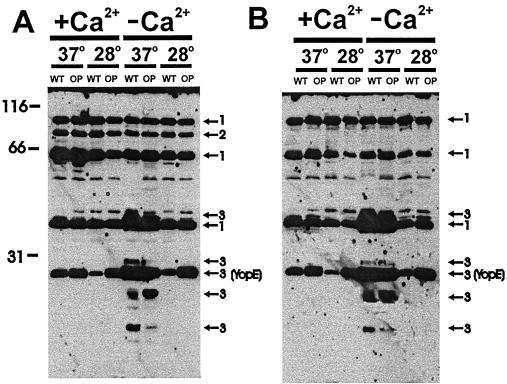FIG. 3.
Mice vaccinated with Dam-overproducing Yersinia strains show an altered humoral response compared to mice infected with wild-type Yersinia strains. Whole-cell protein extracts from wild-type (WT) and Dam-overproducing (OP) Y. pseudotuberculosis grown under the indicated temperature and calcium conditions served as the antigen source. Whole-cell protein extracts derived from 2.0 × 106 cells (∼20 μg of protein/well) were subjected to sodium dodecyl sulfate-polyacrylamide gel electrophoresis, transferred to polyvinylidene difluoride membrane (Pierce), and probed with Dam+ (A) or Dam-overproducing (B) pooled convalescent antisera at a 1/15,000 or a 1/7500 dilution of antibody, respectively. Peroxidase-conjugated sheep anti-mouse immunoglobulin G (Amersham Life Sciences) was used as the secondary antibody at 1/40,000 dilution, and hybridization was detected by using Supersignal West Femto Maximum Sensitivity Substrate (Pierce). Group 1 antigens were produced by wild-type and Dam-overproducing strains in vitro and recognized by both wild-type and Dam-overproducing convalescent-phase antisera (arrows 1). Group 2 antigen was produced by wild-type and Dam-overproducing strains in vitro and preferentially recognized by wild-type convalescent-phase antisera (arrows 2). Group 3 antigens were expressed under Yop inducing conditions (low Ca2+ and high temperature) and were preferentially produced by either Dam+ or Dam-overproducing cells in vitro (arrows 3). Numbers refer to protein sizes in kilodaltons. To generate the wild-type and Dam-overproducing convalescent-phase sera, 6- to 8-week-old BALB/c mice were gastrointubated with 2.5 × 107 wild-type Y. pseudotuberculosis (the lethal dose required to kill 50% of the animals [21]) or 2.5 × 1010 Dam-overproducing Y. pseudotuberculosis bacteria. At 5 weeks postimmunization, whole blood from four to six mice was collected by cardiac puncture, and the sera were pooled and stored in 20% glycerol at −20°.

